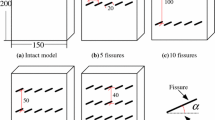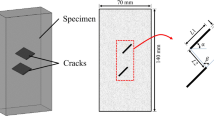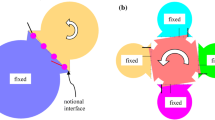Abstract
The initiation and propagation of microcracks along preexisting fissures is one of the typical failure modes for inherently fractured rocks in geotechnical engineering. To better capture the growth of such microcracks, an improved transparent rock-like resin sample with preexisting fissures is first proposed and applied in three-dimensional uniaxial compression test to vividly reproduce the dynamic growth of microcracks due to fissures reactivation. An analytical mathematical solution for calculating the growth length of wing-shaped cracks is derived with the help of the composite fracture strength criterion. The theoretical values agree well with the experimental results. In addition, further investigations on the microcracking mechanism as well as its influence factors induced by the combined interaction of double parallel fissures are carried out under the framework of particle flow simulations. Results suggest that the microcracks induced by fissure reactivation, they begin to appear when the loading stress reaches 50% of the peak stress (σp), develop rapidly after surpassing 70% σp and expand more slowly beyond 80% σp. Especially in the case of double-fissures, some counter-wing and petal-shaped cracks will finally form in the later stages of microcracks propagation, with a length of approximately 1/3–1/2 of the minor axis of the preexisting fissures.
Highlights
-
The newly improved rock-like resin specimen has the ability to reproduce the mechanical behaviors of red sandstone sample in terms of deformation and rupture;
-
The dynamic growth of wing-shaped cracks induced by fissure reactivation is experimentally studied using rock-like resin sample containing initial preset fissures;
-
A mathematical solution for calculating the growth length of wing-shaped cracks under the combined interaction of double parallel fissures is derived theoretically;
-
The growth mechanism of wing-shaped cracks as well as their effect factors is further explored numerically by capturing the initiation and propagation of induced microcracks.






















Similar content being viewed by others
Data availability
The data that support the findings of this study are available from the corresponding author upon reasonable request.
Abbreviations
- K I, K II :
-
Stress factors of I and II type tips of fissures
- K I c, K II c :
-
Plane strain fracture toughness of materials
- K I :
-
Stress intensity factor at the tips of fissure
- K n, K s :
-
Normal and tangential stiffnesses of joints respectively
- \({K}_{1}^{n}\),\({K}_{1}^{s}\) :
-
Stress intensity factor in a normal and tangential direction
- U :
-
Triggered energy related to stress change
- U 0 :
-
Elastic energy of the unit body
- U n(x):
-
Normal displacement of induced microcrack surface
- U s(x):
-
Tangential displacement of induced microcrack surface
- T n :
-
Driving force of induced microcrack
- T s :
-
Driving force to slide of induced microcrack
- W :
-
The work done by the force on the initial and secondary crack face
- P :
-
Total energy of the unit
- F :
-
Fissure interaction effect factor
- Β :
-
Parameter determined by experimental regression analysis
- σ xy , σ xx :
-
Stress components around fissures
- σ 1 , σ 2 , σ 3 :
-
Principal stresses
- α 1 :
-
Correction factor considering the inherent fissure
- α 2 :
-
Correction factor for the shape of the crack
- α 3 :
-
A constant related to experimental material
- α :
-
Angle between inherent fissure and horizontal direction
- β n :
-
Material coefficient related to normal displacement
- β s :
-
Material coefficient related to shear displacement
- ψ :
-
Angle between inherent fissure and σ1 direction
- θ :
-
Angle between induced crack and horizontal direction
- f :
-
Sliding friction coefficient of cracked surface
- σ θθ :
-
Shear stress
- s 1 , s 2 :
-
Cracking surface of the inherent fissure and induced microcracks
- x :
-
Distance from the calculated point to the center (O) of fissure
- δ :
-
Maximum displacement of the inherent fissure center point
- δ n :
-
Normal displacement
- δ s :
-
Tangential displacement
- r :
-
Parameter determined by experimental regression analysis
- 2a :
-
Fissure length
- l :
-
Crack growth length
- π :
-
Pi
References
Anderson TL (2017) Fracture mechanics: fundamentals and applications. CRC Press
Ashby MF, Hallam S (1986) The failure of brittle solids containing small cracks under compressive stress states. Acta Metall 34(3):497–510
Bahaaddini M, Sheikhpourkhani AM, Mansouri H (2021) Flat-joint model to reproduce the mechanical behaviour of intact rocks. Eur J Environ Civ Eng 25(8):1427–1448
Brace W, Bombolakis E (1963) A note on brittle crack growth in compression. J Geophys Res 68(12):3709–3713
Chen X, Tang M, Tang CA (2021) Effect of confining pressure on the damage evolution and failure behaviors of intact sandstone samples during cyclic disturbance. Rock Mech Rock Eng 1–15
Cheng Y, Wong LNY (2020) A study on mechanical properties and fracturing behavior of Carrara marble with the flat-jointed model. Int J Numer Anal Meth Geomech 44(6):803–822
Dyskin A, Jewell R, Joer H, Sahouryeh E, Ustinov K (1994) Experiments on 3-D crack growth in uniaxial compression. Int J Fract 65(4):77–83
Dyskin A, Sahouryeh E, Jewell R, Joer H, Ustinov K (2003) Influence of shape and locations of initial 3-D cracks on their growth in uniaxial compression. Eng Fract Mech 70(15):2115–2136
Fu J, Liu S, Li L, Wang J (2020) A modelling resin material and its application in rock-failure study: samples with two 3D internal fracture surfaces. Open Geosci 12(1):1237–1246
Fu J, Labuz JF, Guo M, Cheng H, Hou R (2022) "Experimental and numerical investigations on hydraulic fracture growth using rock-like resin material containing an injecting inner pre-crack. J Petrol Sci Eng 213:110424
Gdoutos EE (2020) Fracture mechanics: an introduction. Springer Nature
Guo Y, Lin C, Zhu W, Li S (2008) Experimental research on propagation and coalescence process of three-dimensional flaw-sets. Chin J Rock Mech Eng 27(9):3191–3195
Haeri H, Sarfarazi V, Zhu Z (2017) Effect of normal load on the crack propagation from pre-existing joints using particle flow code (PFC). Comput Concr 19(1):99–110
Kaiser P, Yazici S, Maloney S (2001) Mining-induced stress change and consequences of stress path on excavation stability—a case study. Int J Rock Mech Min Sci 38(2):167–180
Knauss W (1970) An observation of crack propagation in anti-plane shear. Int J FractMech 6(2):183–187
Lajtai E (1974) Brittle fracture in compression. Int J Fract 10:525–536
Li Y, Cai W, Li X, Zhu W, Zhang Q, Wang S (2019) Experimental and DEM analysis on secondary crack types of rock-like material containing multiple flaws under uniaxial compression. Appl Sci 9(9):1749
Lin Q, Cao P, Wen G, Meng J, Cao R, Zhao Z (2021) Crack coalescence in rock-like specimens with two dissimilar layers and pre-existing double parallel joints under uniaxial compression. Int J Rock Mech Min Sci 139:104621
Ma XG, Liguo XB et al (2022) Basic mechanical properties and failure mechanism of red sandstone under biaxial loading condition. J Shandong Univ Sci Technol 41(03):58–65
Mousavi SZS, Tavakoli H, Moarefvand P, Rezaei M (2019) Assessing the effect of freezing-thawing cycles on the results of the triaxial compressive strength test for calc-schist rock. Int J Rock Mech Min Sci 123:104090
Que X, Zhu Z, Zhou L, Niu Z, Huang H (2022) Strength and failure characteristics of an irregular columnar jointed rock mass under polyaxial stress conditions. Rock Mech Rock Eng 55(11):7223–7242
Rabczuk T, Bordas S, Zi G (2010) On three-dimensional modelling of crack growth using partition of unity methods. Comput Struct 88(23–24):1391–1411
Schöpfer MP, Abe S, Childs C, Walsh JJ (2009) The impact of porosity and crack density on the elasticity, strength and friction of cohesive granular materials: insights from DEM modelling. Int J Rock Mech Min Sci 46(2):250–261
Schwarz HA (1870) Ueber einen Grenzübergang durch alternirendes Verfahren, Zürcher u. Furrer
Wang Z, Li Y, Cai W, Zhu W, Kong W, Dai F, Wang C, Wang K (2021) Crack propagation process and acoustic emission characteristics of rock-like specimens with double parallel flaws under uniaxial compression. Theoret Appl Fract Mech 114:102983
Wang F, Zhang D, Huang H, Huang Q (2023a) A phase-field-based multi-physics coupling numerical method and its application in soil–water inrush accident of shield tunnel. Tunn Undergr Space Technol 140:105233
Wang F, Zhou M, Shen W, Huang H, He J (2023b) Fluid-solid-phase multi-field coupling modeling method for hydraulic fracture of saturated brittle porous materials. Eng Fract Mech 286:109231
Wang S, Yang X, Li W, Qiao W (2023c) Influence of a rock bridge on the shearing behavior of nonpersistent rough joints: an experimental study. Rock Mech Rock Eng 56:1–16
Wei C, Li S, Zhang B, Song Y, Zhang Y, Wang X (2023) Experimental and numerical investigation on crack propagation and coalescence in rock-like specimens with fluid-infiltrated parallel flaws. Rock Mech Rock Eng 56(3):1995–2015
Wong R, Huang ML, Jiao MR, Tang CA, Zhu WS (2004) The mechanisms of crack propagation from surface 3-D fracture under uniaxial compression. Key Engineering materials. Trans Tech Publ
Wu S-Y, Huang Y-H (2023) Macro and meso crack evolution of granite specimens with non-straight fissures: a comparison between two bond models. Theoret Appl Fract Mech 125:103890
Wu T, Gao Y, Zhou Y, Li J (2020) Experimental and numerical study on the interaction between holes and fissures in rock-like materials under uniaxial compression. Theoret Appl Fract Mech 106:102488
Xia K, Chen C, Liu X, Liu X, Yuan J, Dang S (2023) Assessing the stability of high-level pillars in deeply-buried metal mines stabilized using cemented backfill. Int J Rock Mech Min Sci 170:105489
Xu R, Zhang S, Li Z, Yan X (2023) Experimental investigation of the strain rate effect on crack initiation and crack damage thresholds of hard rock under quasi-static compression. Acta Geotech 18(2):903–920
Yang S-Q (2011) Crack coalescence behavior of brittle sandstone samples containing two coplanar fissures in the process of deformation failure. Eng Fract Mech 78(17):3059–3081
Yang S-Q, Tian W-L, Huang Y-H, Ranjith P, Ju Y (2016) An experimental and numerical study on cracking behavior of brittle sandstone containing two non-coplanar fissures under uniaxial compression. Rock Mech Rock Eng 49:1497–1515
Zare S, Karimi-Nasab S, Jalalifar H (2021) Analysis and determination of the behavioral mechanism of rock bridges using experimental and numerical modeling of non-persistent rock joints. Int J Rock Mech Min Sci 141:104714
Zhang Y, Shao J, Liu Z, Shi C, De Saxcé G (2019) Effects of confining pressure and loading path on deformation and strength of cohesive granular materials: a three-dimensional DEM analysis. Acta Geotech 14:443–460
Zhang Y, Liu Z, Han B, Zhu S, Zhang X (2022) Numerical study of hydraulic fracture propagation in inherently laminated rocks accounting for bedding plane properties. J Petrol Sci Eng 210:109798
Zhou X, Qian Q, Yang H (2011) Rock burst of deep circular tunnels surrounded by weakened rock mass with cracks. Theoret Appl Fract Mech 56(2):79–88
Zhou J, Li X, Mitri HS (2018) Evaluation method of rockburst: state-of-the-art literature review. Tunn Undergr Space Technol 81:632–659
Zhu Z (2013) Evaluation of the range of horizontal stresses in the earth’s upper crust by using a collinear crack model. J Appl Geophys 88:114–121
Zhu Q-Z, Shao J-F (2020) A semi-empirical failure criterion for brittle rocks. Rock Mech Rock Eng 53:4271–4277
Zhu S, Zheng JH, Zhu ZD, Zhu QZ, Zhou LM (2022) Experiments on three-dimensional flaw dynamic evolution of transparent rock-like material under osmotic pressure. Tunn Undergr Space Technol 128:104624
Zhu S, Wang H, Zhu Q, Wang Y (2023) Experimental and numerical simulation of three-point bending fracture of brittle materials with inverted T-shaped obstacle cracks. Theor Appl Fract Mech 128:104155
Zhu S (2021) Experimental study on the evolution of the spatial distribution of built-in cracks in quasi-rock materials. Hohai University
Zhuang X, Zhou S (2020) An experimental and numerical study on the influence of filling materials on double-crack propagation. Rock Mech Rock Eng 53(12):5571–5591
Zi G, Belytschko T (2003) New crack-tip elements for XFEM and applications to cohesive cracks. Int J Numer Meth Eng 57(15):2221–2240
Acknowledgements
This study has been jointly supported by the National Natural Science Foundation of China (Grant No. 12372374, 42307192 and 41831278), the CRSRI Open Research Program (Grant No. CKWV20231175/KY), and the Fundamental Research Funds for the Central Universities (Grant No. 022123030).
Author information
Authors and Affiliations
Corresponding author
Additional information
Publisher's Note
Springer Nature remains neutral with regard to jurisdictional claims in published maps and institutional affiliations.
Appendix 1
Appendix 1
Derivation of the total displacement.
When the initial microcracks begin to slide, the total energy induced by the driven force on the fissure surface can be obtained from Eq. (11) and that is:
where the first component denotes the work by the shear sliding force on the initial crack plane, and the second component represents the work done as the wing crack overcomes σ3.
When L < 1, we can further get the following simplified formula as:
The displacement δ in Eq. (A-2) can be decomposed into two components in tangential and normal directions (δs, δn), and that is:
According to the reference of (Ashby et al. 1986), the opening displacement δn at the center of a straight crack is assumed to only affect a stress field in a zone of (l + a) and thus results in elastic energy accumulation. The corresponding elastic energies variation can be expressed by:
where α3 is a constant related to experimental material. The total strain energy can be obtained by:
According to the assumption above and keeping the minimum energy of the sliding displacement, we can get the following formula as:
Then, by combining Eqs. (A-1), (A-5) and (A-6) and neglecting the initial elastic stain energy U0, the total displacement can be calculated and expressed by:
Rights and permissions
Springer Nature or its licensor (e.g. a society or other partner) holds exclusive rights to this article under a publishing agreement with the author(s) or other rightsholder(s); author self-archiving of the accepted manuscript version of this article is solely governed by the terms of such publishing agreement and applicable law.
About this article
Cite this article
Zhu, S., Zhang, Y., Shao, J. et al. Experimental and Theoretical Study on Crack Growth Using Rock-Like Resin Samples Containing Inherent Fissures and its Numerical Assessment. Rock Mech Rock Eng (2024). https://doi.org/10.1007/s00603-024-03807-8
Received:
Accepted:
Published:
DOI: https://doi.org/10.1007/s00603-024-03807-8




